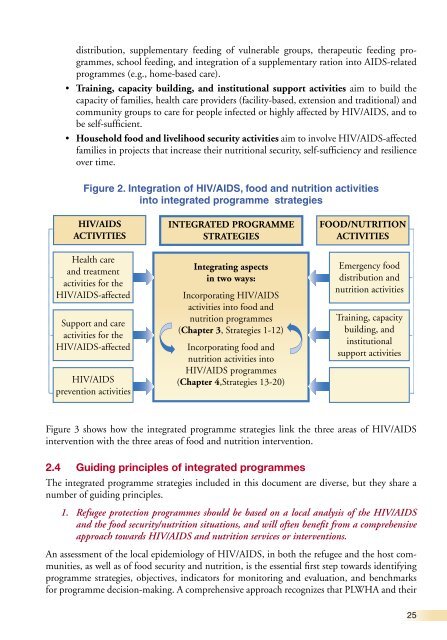Integration of HIV/AIDS activities with food and nutrition support in ...
Integration of HIV/AIDS activities with food and nutrition support in ...
Integration of HIV/AIDS activities with food and nutrition support in ...
Create successful ePaper yourself
Turn your PDF publications into a flip-book with our unique Google optimized e-Paper software.
distribution, supplementary feed<strong>in</strong>g <strong>of</strong> vulnerable groups, therapeutic feed<strong>in</strong>g programmes,<br />
school feed<strong>in</strong>g, <strong>and</strong> <strong>in</strong>tegration <strong>of</strong> a supplementary ration <strong>in</strong>to <strong>AIDS</strong>-related<br />
programmes (e.g., home-based care).<br />
• Tra<strong>in</strong><strong>in</strong>g, capacity build<strong>in</strong>g, <strong>and</strong> <strong>in</strong>stitutional <strong>support</strong> <strong>activities</strong> aim to build the<br />
capacity <strong>of</strong> families, health care providers (facility-based, extension <strong>and</strong> traditional) <strong>and</strong><br />
community groups to care for people <strong>in</strong>fected or highly affected by <strong>HIV</strong>/<strong>AIDS</strong>, <strong>and</strong> to<br />
be self-sufficient.<br />
• Household <strong>food</strong> <strong>and</strong> livelihood security <strong>activities</strong> aim to <strong>in</strong>volve <strong>HIV</strong>/<strong>AIDS</strong>-affected<br />
families <strong>in</strong> projects that <strong>in</strong>crease their <strong>nutrition</strong>al security, self-sufficiency <strong>and</strong> resilience<br />
over time.<br />
Figure 2. <strong>Integration</strong> <strong>of</strong> <strong>HIV</strong>/<strong>AIDS</strong>, <strong>food</strong> <strong>and</strong> <strong>nutrition</strong> <strong>activities</strong><br />
<strong>in</strong>to <strong>in</strong>tegrated programme strategies<br />
<strong>HIV</strong>/<strong>AIDS</strong><br />
ACTIVITIES<br />
Health care<br />
<strong>and</strong> treatment<br />
<strong>activities</strong> for the<br />
<strong>HIV</strong>/<strong>AIDS</strong>-affected<br />
Support <strong>and</strong> care<br />
<strong>activities</strong> for the<br />
<strong>HIV</strong>/<strong>AIDS</strong>-affected<br />
<strong>HIV</strong>/<strong>AIDS</strong><br />
prevention <strong>activities</strong><br />
INTEGRATED PROGRAMME<br />
STRATEGIES<br />
Integrat<strong>in</strong>g aspects<br />
<strong>in</strong> two ways:<br />
Incorporat<strong>in</strong>g <strong>HIV</strong>/<strong>AIDS</strong><br />
<strong>activities</strong> <strong>in</strong>to <strong>food</strong> <strong>and</strong><br />
<strong>nutrition</strong> programmes<br />
(Chapter 3, Strategies 1-12)<br />
Incorporat<strong>in</strong>g <strong>food</strong> <strong>and</strong><br />
<strong>nutrition</strong> <strong>activities</strong> <strong>in</strong>to<br />
<strong>HIV</strong>/<strong>AIDS</strong> programmes<br />
(Chapter 4,Strategies 13-20)<br />
FOOD/NUTRITION<br />
ACTIVITIES<br />
Emergency <strong>food</strong><br />
distribution <strong>and</strong><br />
<strong>nutrition</strong> <strong>activities</strong><br />
Tra<strong>in</strong><strong>in</strong>g, capacity<br />
build<strong>in</strong>g, <strong>and</strong><br />
<strong>in</strong>stitutional<br />
<strong>support</strong> <strong>activities</strong><br />
Figure 3 shows how the <strong>in</strong>tegrated programme strategies l<strong>in</strong>k the three areas <strong>of</strong> <strong>HIV</strong>/<strong>AIDS</strong><br />
<strong>in</strong>tervention <strong>with</strong> the three areas <strong>of</strong> <strong>food</strong> <strong>and</strong> <strong>nutrition</strong> <strong>in</strong>tervention.<br />
2.4 Guid<strong>in</strong>g pr<strong>in</strong>ciples <strong>of</strong> <strong>in</strong>tegrated programmes<br />
The <strong>in</strong>tegrated programme strategies <strong>in</strong>cluded <strong>in</strong> this document are diverse, but they share a<br />
number <strong>of</strong> guid<strong>in</strong>g pr<strong>in</strong>ciples.<br />
1. Refugee protection programmes should be based on a local analysis <strong>of</strong> the <strong>HIV</strong>/<strong>AIDS</strong><br />
<strong>and</strong> the <strong>food</strong> security/<strong>nutrition</strong> situations, <strong>and</strong> will <strong>of</strong>ten benefit from a comprehensive<br />
approach towards <strong>HIV</strong>/<strong>AIDS</strong> <strong>and</strong> <strong>nutrition</strong> services or <strong>in</strong>terventions.<br />
An assessment <strong>of</strong> the local epidemiology <strong>of</strong> <strong>HIV</strong>/<strong>AIDS</strong>, <strong>in</strong> both the refugee <strong>and</strong> the host communities,<br />
as well as <strong>of</strong> <strong>food</strong> security <strong>and</strong> <strong>nutrition</strong>, is the essential first step towards identify<strong>in</strong>g<br />
programme strategies, objectives, <strong>in</strong>dicators for monitor<strong>in</strong>g <strong>and</strong> evaluation, <strong>and</strong> benchmarks<br />
for programme decision-mak<strong>in</strong>g. A comprehensive approach recognizes that PLWHA <strong>and</strong> their<br />
25

















